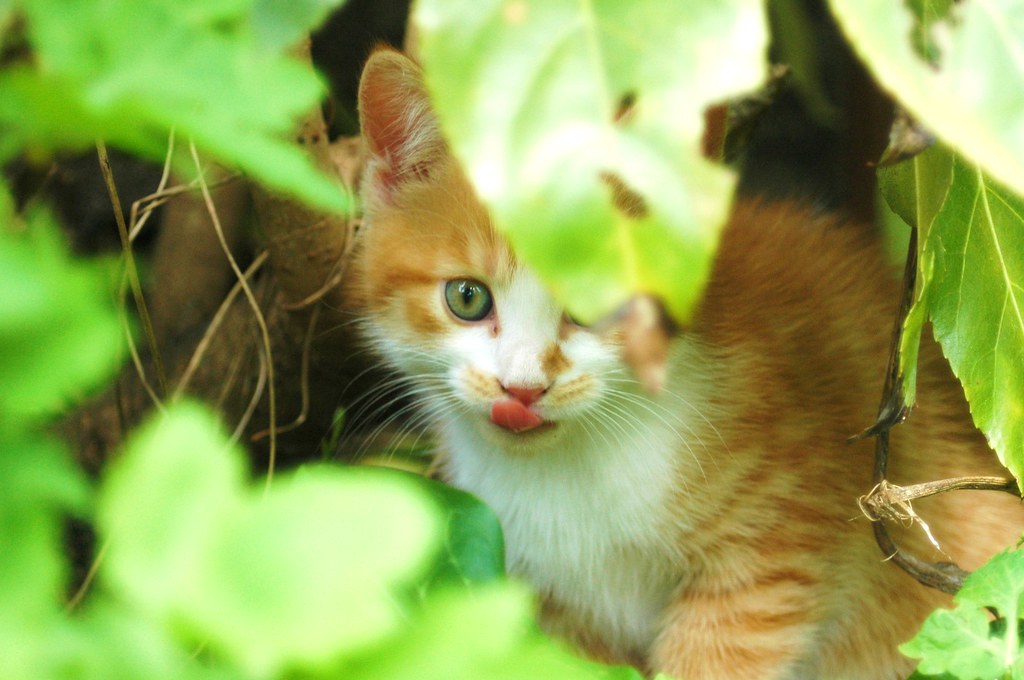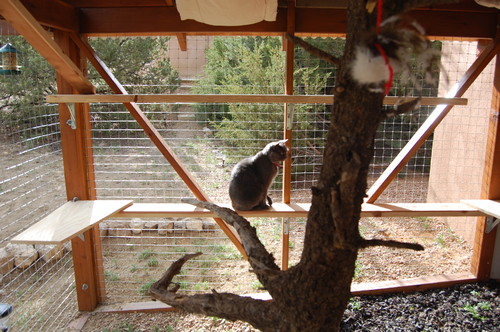How to Create a Cat-Friendly Yard

As fairly independent characters, cats seem to make due in a variety of circumstances. However, if you want to tweak a backyard design with the cat in mind, there are definitely things that can be done.
Whether or not you decide to contain the cat outside versus letting it run free is up to you. However, it is wise to check local ordinances as some require containing household cats. If you’ve adopted a cat from a rescue group, they may have mandated the cat be kept indoors to prevent risk of wandering off. Statistics show that free-roaming cats have significantly lower life spans than those that are contained.
Cat Fencing
Containing a cat outdoors may sound impossible but outsmarting a feline not with an appropriate strategy.
Cat fencing, if used properly, allows cats to enjoy the best of both indoor and outdoor spaces. Basically, since cats can jump rather high, a cat-proof fence places a 45° inward angle at the top of a standard fence height (in San Diego, this is 6′) so that your cat can’t jump over the fence. A number of companies manufacture specialized cat fencing that can be applied to new and existing fences. If it sounds like too much fence, enlist the help of a landscape professional who can mute the design and turn it into something artistic. You’ll also need to check permitting requirements depending on the final fence height.
Be sure to use a sturdy material like metal or wood on the angled part of your cat fence. Many homeowners opt for plastic which doesn’t wear as well and is easy for squirrels and other animals to chew through.
Eliminate Gaps
It’s amazing how cats can navigate through small crevices. Make sure there isn’t a single gap in fencing that is larger than a few inches. While many couldn’t fit their entire bodies through that small of a space, curious cats are known for sticking their paws through holes just for fun and you really never know what’s on the other side that could harm them. Don’t tempt them to break free if you don’t have to. When cats become comfortable in their environment, they are less likely to escape.
Add a Patch of Grass
Cats like to sunbathe on grass. If your backyard is full of hardscape like pavers, as is common these days with concerns about water use and the California drought, it’s easy to add a small patch of sod for the cat. Go to a local nursery and buy a small rectangle to roll out in an underutilized part of the yard or in a tub for the cat to find. Watering the sod will keep it alive. It really doesn’t have to be much bigger than the cat. Some homeowners tuck sod into large container plantings to let the cats luxuriate there.
Have no fear that your cat will reject a lawn replacement strategy. Artificial grass looks and feels much like the real thing and would serve as a water-wise way to add soft grass to an outdoor living space for your cat.
Give them a Place to Hide
Cats like privacy. The odds are that your yard already has safe nooks and crannies for cats to cozy in to. However, it’s easy to create them using a grouping of container plants or by hollowing spaces out under exiting plantings that cats can seek shelter from the sun (or, let’s face it… you).
Cover Sandboxes
Needless to say that many cats use sandboxes as oversized litter boxes which isn’t ideal for the kids. Keep them covered to avoid buried unpleasant surprises.
Cat Houses and Pens
If specialized cat fencing isn’t ideal, outdoor cat houses and pens are becoming en vogue as secure spots for cats to catch fresh air and sunshine. Custom cat houses could be a fun DIY project and are typically open-air with chicken wire or other mesh around the sides and varying levels to climb around in and nap on. As you can see, it’s possible to build a cat house around tree trunks. This one seems to have toys attached to it, too.
Speaking of naps, this lucky cat’s house has a hammock that even humans might be jealous of.
Cat pens are like fully-enclosed portable play pens for cats that can be placed in the yard while doubling as a helpful travel accessory for those who hit the road with their feline. They are much less expensive and easier to manage than a cat house, but certainly not as large.
Edible Plants for Cats
Cats may be carnivores but they do crave greens. Why not plant a few they can enjoy?
Catnip —
Yes, you probably already guessed the first plant correctly… catnip. It’s a beautiful herb that is a member of the mint family. The ecstasy-style reaction that some (not all) cats experience after smelling or rolling around in catnip lasts for only a few minutes.
When cats actually eat catnip, they’re more likely to become mellow so not to worry if you see them chomping on it.
Catmint —
A relative of catnip, catmint is an easy-to-grow perennial with grey-green leaves and gorgeous purple flowers. Bees and other pollinators love the flowers.
Keep in mind that cats love to roll around in catmint and catnip so plan on having it flattened a bit.
Cat grass —
It looks like wheatgrass but cat grass satisfies a cat’s craving for greens and is easily grown from seed in about a week. Experts argue that it’s safest to grow indoors in a container but you can place it outside during your cat’s outdoor play time. Find cat grass seeds at a local pet store.
Of course, there are plants that you’ll want to avoid altogether so do research before planting anything, especially around the plants listed above that felines gravitate toward. Do your research. You’ll definitely want to avoid these plants and also use the ASPCA’s toxic plant list as a resource.
- See also: How to create a dog-friendly yard
Your Turn…
How do you create a cat-friendly yard?
Photo credits: top, Flickr/icathing; cat in plants, Flickr/stevepj2009; catnip, Flickr/izik




